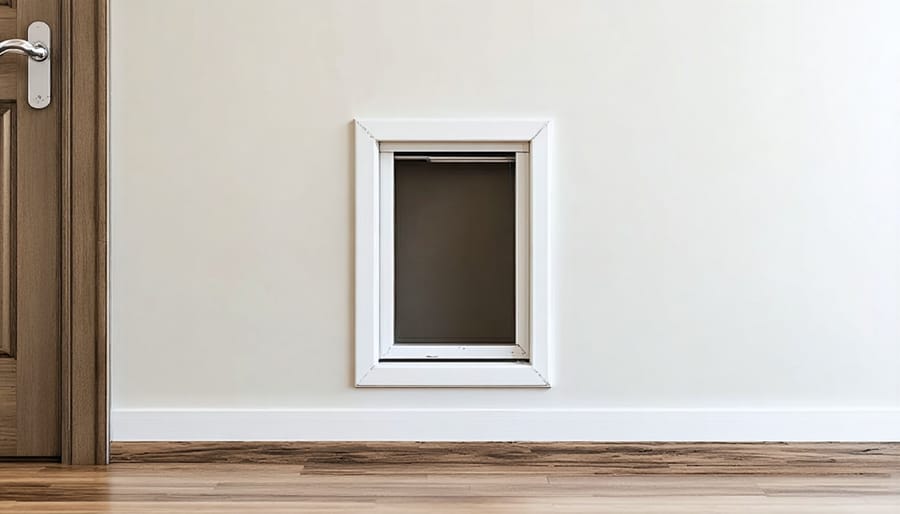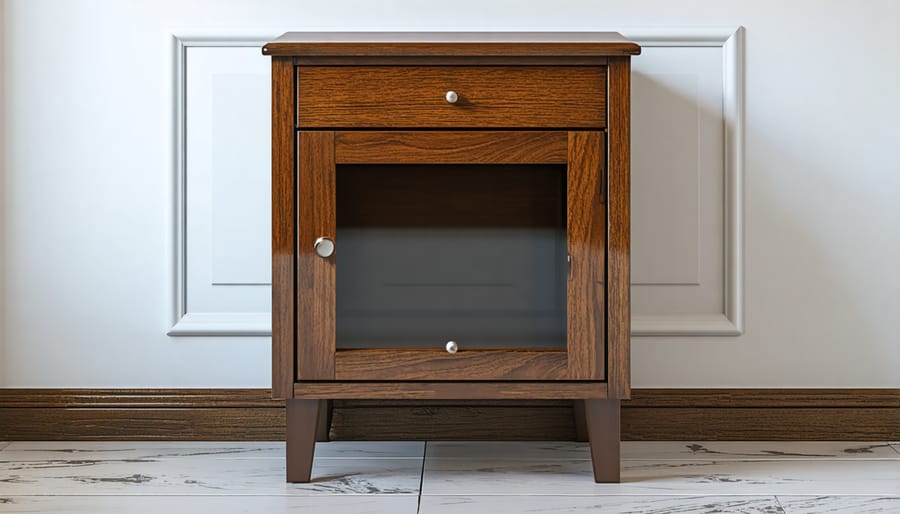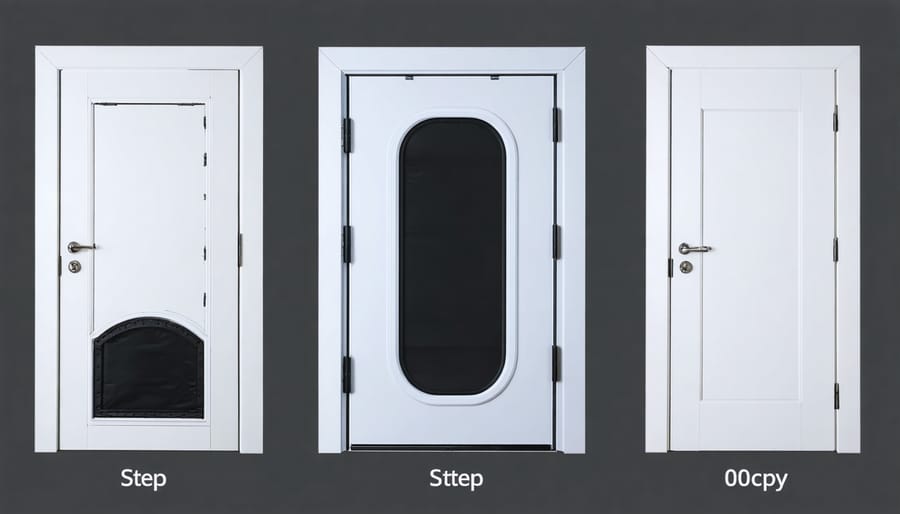Transform your living spaces with stylish interior pet doors that blend seamlessly into your pet-friendly home design. Modern pet door solutions now include hidden pocket doors that slide discreetly into walls, designer-crafted panels matching your existing millwork, and automated systems controlled via smartphone. Install these innovative access points between commonly used spaces—like from the kitchen to the mudroom or bedroom to laundry area—to give pets independence while maintaining your home’s aesthetic appeal. Consider clear acrylic options for a minimalist look, or opt for painted wooden designs that disappear into baseboards and door frames. Strategic placement and proper sizing ensure both functionality for your furry friends and preserved visual harmony throughout your home, making interior pet doors an essential element of contemporary pet-inclusive architecture.
Types of Interior Pet Doors That Complement Your Decor
Hidden Panel Pet Doors
Hidden panel pet doors represent the perfect fusion of functionality and interior design, seamlessly blending into your home’s baseboards or walls. These innovative solutions are virtually invisible when closed, maintaining your home’s clean aesthetic while providing your pets with the freedom they need.
These clever installations typically feature a spring-loaded or magnetic mechanism that allows the panel to swing open when your pet pushes through, then close automatically behind them. You’ll find options that can be installed within existing baseboards, creating a discreet passageway that’s barely noticeable to visitors.
For wall installations, hidden panel pet doors can be designed to match your wall color and texture, making them practically disappear when closed. Some models even come with decorative covers that can be painted or wallpapered to match your existing décor perfectly.
Installation typically requires precise cutting and fitting, so while DIY is possible for experienced homeowners, professional installation is recommended to ensure proper functionality and seamless integration with your home’s architecture. The result is a sophisticated solution that keeps both design-conscious homeowners and their furry friends happy.

Designer Pet Door Frames
Gone are the days when pet doors were merely functional eyesores. Today’s designer pet door frames transform these necessary fixtures into stylish pet-friendly solutions that complement your home’s interior design. From elegant brushed nickel frames that match your door hardware to rich wooden borders that blend seamlessly with your trim, these decorative options make pet accessibility both beautiful and practical.
Consider frames with crown molding details for traditional homes, or sleek, minimalist designs for contemporary spaces. Some manufacturers offer customizable frames that can be painted or stained to match your existing décor perfectly. For the design-conscious pet owner, there are even artistic options featuring decorative panels or built-in picture frames above the pet door opening.
Premium materials like solid oak, maple, or metal alloys ensure durability while maintaining aesthetic appeal. Smart design features such as magnetic closures and weather stripping are cleverly concealed within these attractive frames, proving that function and style can coexist beautifully in your home.
Multi-functional Pet Passages
Transform your home’s existing furniture and built-in elements into clever pet passageways with multi-functional solutions. Consider a stylish cabinet with a built-in pet door, perfect for concealing litter boxes while maintaining easy access for your furry friend. Modern designs now feature pet openings integrated into kitchen islands, closet doors, and even stair risers, seamlessly blending function with style. Some innovative options include smart home integration capabilities, allowing you to monitor and control access remotely. For maximum space efficiency, look for hollow bench seating or entertainment centers with discreet pet openings, offering your pets their own dedicated pathways while preserving your home’s clean aesthetic.

Strategic Placement for Maximum Style Impact
Room-to-Room Transitions
Installing pet doors between interior rooms can significantly improve your pet’s mobility while maintaining your home’s privacy and climate control. Start by identifying the most logical routes your pet takes between rooms, such as from the kitchen to the utility room where their food and litter box are kept, or from the living room to their favorite sleeping spot.
When planning room-to-room transitions, consider installing pet doors in hollow-core doors, which are easier to cut and modify than solid doors. For the best results, position the opening at your pet’s shoulder height and make it slightly larger than their width to ensure comfortable passage.
Some homeowners opt for simple swing-style doors for interior transitions, while others prefer magnetic options that seal more tightly. If you’re concerned about aesthetics, look for pet doors that match your interior doors’ finish or can be painted to blend seamlessly.
Before cutting any openings, verify there are no electrical wires or plumbing in the surrounding walls if you’re installing through a wall instead of a door. For rental properties, consider removable options that can be easily patched when you move out.
Remember to introduce your pet to each new door gradually, using treats and positive reinforcement to encourage exploration and use.
Utility Area Access
Creating dedicated pet access to utility areas can revolutionize your home’s functionality while keeping pet supplies organized and out of sight. Consider installing a pet door leading to a laundry room where you can maximize utility spaces by setting up feeding stations, litter boxes, or grooming areas.
A popular option is adding a pet door to an under-stairs storage area, transforming it into a cozy pet nook. This setup keeps pet essentials contained while giving your furry friend their own private space. For mudrooms, consider installing a Dutch-door style pet entrance, allowing easy access while containing mess from outdoor adventures.
Basement access through interior pet doors can create the ultimate pet sanctuary. Install a small door in a basement door or wall, ensuring your pet can reach their designated area without compromising your home’s climate control. For apartment dwellers, consider converting a closet into a pet station with a stylish pet door that matches your interior trim.
Remember to include proper lighting in these utility spaces and ensure adequate ventilation, especially for areas containing litter boxes or feeding stations. Adding washable mats and easy-clean surfaces around these access points will help maintain cleanliness and protect your flooring.
Installation Tips for a Professional Look
Measuring and Planning
Accurate measurements are crucial for achieving seamless home renovations, especially when installing interior pet doors. Start by measuring your pet’s height and width at their shoulders while standing naturally. Add 1-2 inches to these measurements to ensure comfortable passage. For height, measure from the floor to your pet’s shoulders, then add another 2 inches for clearance.
Next, examine your chosen installation location. Most interior pet doors work best in hollow-core doors, though solid doors can also be modified with proper tools. Measure the door’s thickness – standard interior doors are typically 1⅜ inches thick. Mark the intended installation height, keeping in mind that the bottom of the pet door should clear any baseboards.
Create a paper template of the pet door’s dimensions and tape it to your door. This helps visualize the final placement and ensures it won’t interfere with door handles or other hardware. Consider your pet’s habits and mobility – elderly pets might need a lower installation height, while energetic ones might benefit from a slightly higher placement.
Remember to account for both the interior and exterior frames of the pet door when planning your cuts. Double-check all measurements before making any permanent modifications, as even small errors can affect the door’s functionality and appearance.

Finishing Touches
Once you’ve installed your interior pet door, it’s time to make it look like it truly belongs in your space. The key is to ensure the door blends seamlessly with your existing décor while maintaining its functionality. Start by choosing paint or finish colors that match your trim or walls – this simple step can make your pet door appear as though it was always part of your home’s design.
Consider adding decorative molding around the pet door frame to mirror existing architectural elements in your home. This attention to detail can transform a basic pet door into an intentional design feature. For wooden doors, you might want to stain the frame to match nearby furniture or flooring, creating a cohesive look throughout the space.
Don’t forget about both sides of the door. While you might focus on how it looks in your main living space, ensure the finish is consistent on both sides for a polished appearance. If your pet door is installed in a larger door, consider updating the entire door’s hardware to create a coordinated look – brushed nickel or matte black finishes can add a modern touch.
Get creative with camouflage techniques when the door isn’t in use. A decorative curtain panel or a piece of artwork mounted on hinges can cover the opening while adding visual interest to your space. For those who love DIY projects, consider creating a custom frame or surround that complements your home’s style – whether that’s farmhouse chic or contemporary minimal.
Remember that functionality doesn’t have to mean sacrificing style. Keep the area around your pet door clean and well-maintained, and consider placing a decorative mat on both sides to catch paw prints. These thoughtful touches not only enhance the appearance but also make the pet door more practical for daily use.
Maintaining Your Pet Door’s Aesthetics
Cleaning and Care
Keeping your interior pet door clean and well-maintained not only extends its lifespan but also ensures it continues to complement your home’s decor. Regular cleaning is surprisingly simple – just wipe down both sides of the flap and frame with a damp microfiber cloth weekly to remove pet hair, dust, and paw prints. For stubborn dirt, use a mild soap solution, but avoid harsh chemicals that might damage the door’s finish or make your pet reluctant to use it.
Pay special attention to the hinges and moving parts, which can collect debris over time. A quick wipe with a dry cloth followed by a light application of food-grade silicone spray will keep the mechanism working smoothly and quietly. If your pet door has weather stripping or magnetic strips, check these monthly for wear and clean them gently to maintain their effectiveness.
For wooden frames, inspect regularly for moisture damage, especially if the door is near areas where water might splash. Apply appropriate wood treatment annually to prevent warping. Plastic and metal frames are more forgiving but should still be checked for loose screws or mounting hardware every few months.
Remember to clean the surrounding wall area too, as pets might brush against it when using the door. A quick touch-up with paint or wall cleaner can keep the entire installation looking fresh and inviting for both your pets and guests.
When to Update or Replace
Just like any home fixture, interior pet doors need occasional updates or replacement to maintain their functionality and appearance. Here are key signs that it’s time for a refresh:
Watch for visible wear and tear, such as scratched or chipped frames, worn-out flaps, or loose components. These not only look unsightly but can also affect your door’s performance and energy efficiency. If you notice drafts around the pet door or hear rattling sounds when it’s in use, these are clear indicators that replacement parts or a new unit might be necessary.
Consider updating your pet door if it no longer matches your home’s updated décor or if you’ve recently renovated the surrounding area. Modern pet door designs offer sleek, contemporary options that can enhance your interior aesthetic rather than detract from it.
Safety concerns should prompt immediate action. If the door’s locking mechanism isn’t working properly, or if the flap doesn’t seal completely, it’s time for a replacement. Additionally, if your pet’s size has changed significantly – whether they’ve grown larger or become less agile with age – you might need to switch to a more appropriately sized or easily accessible model.
Energy efficiency is another crucial factor. Older pet doors may lack proper insulation, leading to increased heating and cooling costs. If you notice temperature fluctuations near the pet door, consider upgrading to a more energy-efficient model with better sealing technology.
Choosing the right interior pet door is more than just a practical decision – it’s an investment in both your pet’s freedom and your home’s visual appeal. Throughout this guide, we’ve explored various options that prove you don’t have to sacrifice style for functionality when it comes to pet-friendly home modifications.
Remember that successful pet door integration starts with thoughtful planning. Consider your pet’s size and habits, your home’s layout, and your personal design preferences. Whether you opt for a sleek modern design that blends seamlessly with your door or a custom-built solution that becomes a unique architectural feature, there’s a perfect option for every home.
Installation location plays a crucial role in both functionality and aesthetics. By choosing strategic placement – whether in interior doors, walls, or specially designed furniture pieces – you can maintain your home’s flow while providing convenient access for your furry friend. Professional installation, while sometimes more costly upfront, can ensure your pet door looks and functions exactly as intended for years to come.
Regular maintenance and cleaning will keep your pet door looking its best while ensuring smooth operation. Simple steps like wiping down frames, checking seals, and occasional adjustments can extend the life of your installation while preserving its aesthetic appeal.
As our homes continue to evolve to better accommodate our four-legged family members, interior pet doors have come a long way from the basic flap designs of the past. Today’s options prove that practical pet solutions can enhance rather than detract from your interior design. By taking the time to select and install the right pet door, you’re creating a more comfortable environment for your pet while maintaining the sophisticated look you love in your home.
Remember, a well-chosen and properly installed pet door isn’t just a convenience – it’s a thoughtful addition that can seamlessly integrate into your home’s design story while improving quality of life for both you and your pets.
